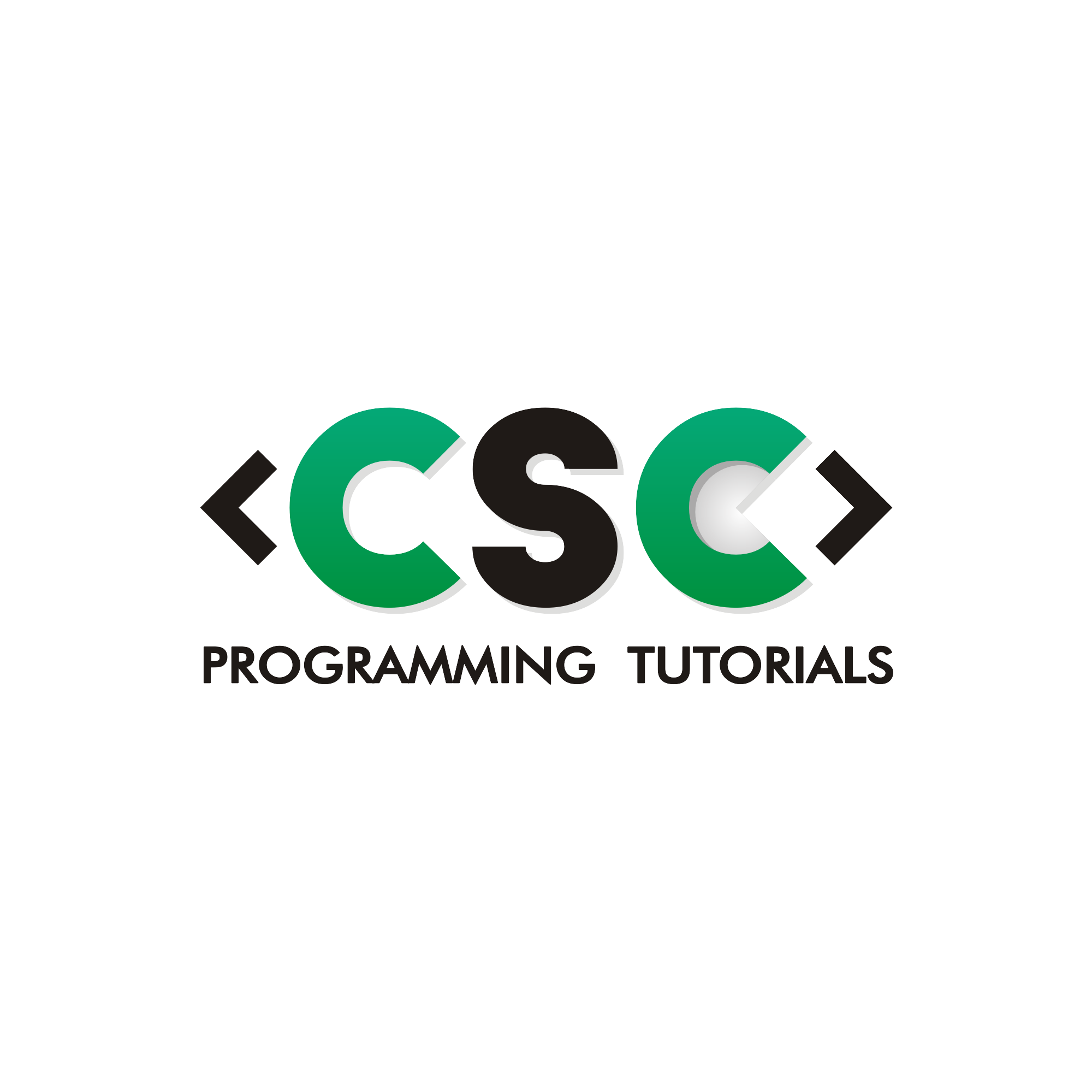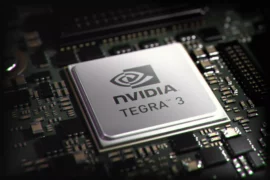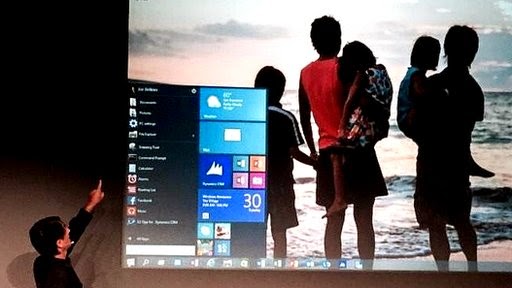 |
| Microsoft announced details of the new operating system at an event in San Francisco |
The software will run on a wide range of devices, from phones and tablets to PCs and Xbox games consoles, with applications sold from a single store.
It also marks the return of the Start Menu, which had been removed from Windows 8.
In addition to offering a list of the user’s favourite applications, the menu also brings up resizable tiles – similar to those featured in Windows 8’s touch-centric interface on PCs and tablets.
These provide a quick view of notifications from relevant applications, such as details of new emails, Facebook messages and weather forecast updates.
The company said the facility was intended to make the software seem familiar to both users of Windows 8 and Windows 7.
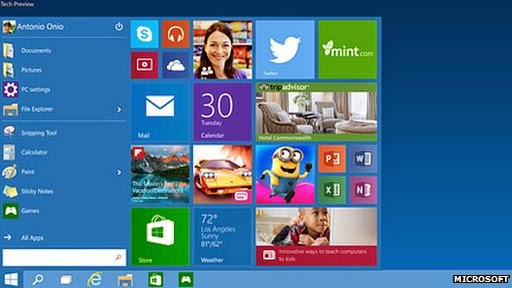 |
| The Start Menu now features both a list of apps and live tiles |
The behaviour of the OS will depend on the type of device with which it is being used. Unlike its predecessor, users will not need to switch between Desktop Mode and the touch-focused alternative.
However, they can still spread a number of “live tiles” across the screens of two-in-one laptop-tablet hybrids to make them easier to use with both a mouse and finger presses.
‘Critical’ choice
Windows 8 had been criticised for being too different from the previous version, which deterred some organisations from introducing it.
It initially lacked a Start button altogether, and when one was introduced, it only switched to the touch-centric tiled interface or – if a long mouse press was used – provided access to the system’s control panel and other functions.
Businesses typically wait about a year after a new operating system’s release before offering it to workers, to give IT staff a chance to get to grips with the new technologies involved.
But it has been nearly two years since Windows 8 first went on sale and adoption is still low.
“It’s extremely important for Microsoft to get Windows 10 right,” said David Johnson, who watches Microsoft for the consultancy Forrester.
“Windows 8 is only being offered to employees by about one in five organisations right now. Windows 7 is still the de facto standard for enterprise in the desktop environment.
“For Microsoft to continue to be able to get the best and latest technology in the hands of the enterprise workforce all over the world, it has to have a vehicle to do that – and Windows 10 is its best shot.”
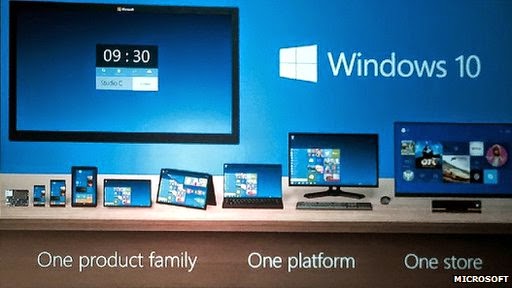 |
| Microsoft said Windows 10 would work on devices with 4in (10.2cm) screens and 80in screens |
Across desktop PCs as a whole, only 13.4% currently run Windows 8 or Windows 8.1, according to research firm NetMarketshare.
By contrast, it says 51.2% are powered by Windows 7 and 23.9% by Windows XP, a version that is no longer supported by Microsoft.
Mr Johnson said the reintroduction of the Start Menu should help Windows 10 fare better.
“It is critically important,” he said.
“The Start Menu is perhaps the most important thing that will make the desktop experience familiar to business users, and will help reduce resistance to its installation.”
Preview download
Other features include:
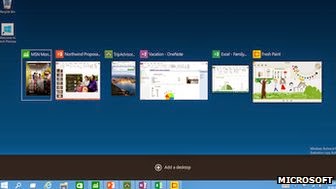 |
| The task-view button offers one-click access to all running apps and files |
-
- Snap enhancements – a new “quadrant layout” will allow four apps to be easily arranged on the same screen.
-
- Task view – a new button on the task bar will let the user see all open apps and files, helping them switch from one to another.
-
- Multiple desktops – users can switch between distinct desktop screens, allowing them to group related work together rather than having to deal with a single screen overloaded with documents and apps. This is similar to a feature already available on Apple’s Mac OS.
Microsoft will offer a “technical preview” of Windows 10 to early adopters later this week, which will run on laptops and desktops. A release that will work on computer servers will follow.
Analysis: Richard Taylor, North America technology correspondent
Microsoft has a delicate balancing act as it attempts to cater to a diverse audience using a cornucopia of devices, from traditional keyboard/mouse-based PCs to tablets.
It got that balance wrong with Windows 8 – which many users felt was skewed towards the touchscreen at the expense of the familiar PC desktop experience that they had come to know intimately.
I asked Terry Myerson, the chief of operating systems at Microsoft, why the leadership had chosen the moniker Windows 10, rather than the more logical Windows 9.
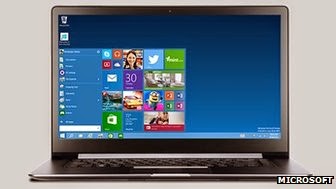 |
|
Microsoft is inviting members of the public to provide
feedback about an early version of Windows 10
|
He told me somewhat obliquely that it resonated best for what the company would deliver across the breadth of devices. Unifying a brand across all devices is key to Microsoft’s vision.
But the Windows 10 name also symbolises that this will not be an incremental update, but something of a fresh start.
The user interface feels familiar yet modern. The “dual mode” – which aimed to satisfy tablet and PC users, but alienated both – has been replaced with a dynamically-adjusting interface and behaviour, determined by whether you are using a keyboard/mouse, or touch.
Ultimately Windows 10 success will depend on its execution. But at least under the new leadership, Microsoft is showing it is listening. It needs to if it is to stay relevant and stop the march of Android and Apple.
The company said it would provide details about the introduction of “universal apps” – individual programs that tailor their functionality to different types of devices – at its Build conference in April, and would aim to release the completed OS before the end of 2015.
There was no mention of offering the firm’s voice-controlled digital assistant Cortana to PCs, or when Windows 10 would supersede the Windows Phone OS.
The firm’s smartphone code is designed for ARM-based processors, unlike the main Windows 8 and Xbox operating systems that are built for x86 chips – including those made by Intel and AMD.
While Microsoft confirmed that Windows 10 would be released for both types of chip architecture, it did not disclose whether there would be a staggered release.
One analyst suggested that by using a single OS to power a wide range of devices, it might increase the amount of software available to all of them.
“The idea is, longer-term, to encourage developers to release more apps for Windows,” said Annette Jump from the tech research firm Gartner.
“That’s Microsoft’s biggest challenge at the moment when it comes to tablets and phones – there are not as many apps as there are for iOS and Android.”
 |
| Windows 10 introduces the ability to switch between two or more desktop screens |
Even so, another expert highlighted that the announcement in San Francisco had been deliberately tailored to appeal to business users.
“The event was clearly geared toward Microsoft’s bread and butter enterprise customer, and we believe starting an early dialogue with these customers as well as learning from previous mistakes made in Redmond – eg Windows 8 – will be key to garnering major adoption of this all-important product cycle in the field,” said Daniel Ives from research firm BlueMatrix.
“Overall, we believe today’s event was another step in the right direction in the [Satya] Nadella era, and that Microsoft remains well positioned… while it undergoes a major restructuring effort to make it a ‘leaner and meaner’ technology giant over the coming years.”
